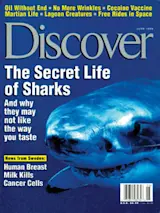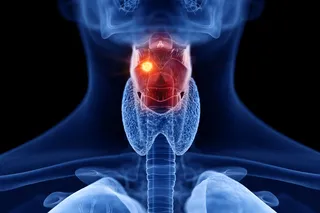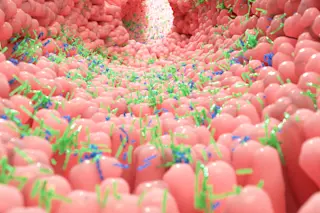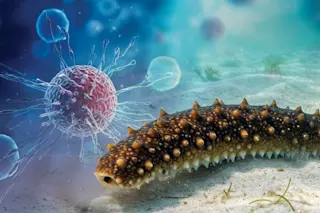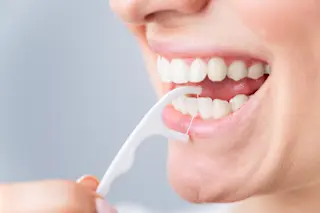When Catharina Svanborg and her research associates began mixing mothers' milk and cancer cells together seven years ago, she wasn't looking for a cure for cancer; she was after a way to fight germs. Nevertheless, the physician and immunologist at Lund University in Sweden has discovered that a previously taken-for-granted component of ordinary human breast milk compels cancer cells--every type of cancercell tested--to die. Now Svanborg must prove her discovery, demonstrating to wary scientists that her surprising find is for real. So far, it hasn't been easy.
“It’s an extremely important observation, interesting and provocative,” says breast cancer researcher David Salomon of the National Cancer Institute. “But it’s novel, and novelty always runs the risk of challenging the current dogma. A lot of times you run up against a brick wall of people who have tunnel vision.”
It doesn’t help that Svanborg’s lab is not a large, high-profile cancer research facility. In fact, it’s not a cancer lab at all; her specialty is an entirely different field, infectious disease. Says Salomon: “If this work had come from a well-known lab at the NCI, you’d have reporters calling six days to Sunday. You’d have scientists eager to collaborate. But it’s coming from a small lab in a foreign country. It’s like General Motors versus a garage operation.”
If so, this is the kind of garage you’d take your Porsche to. Tall, poised, and professional to the core, Svanborg leads a team of dedicated young researchers who have worked overtime to make their discovery matter. With the first phase of research finally finished, the group has decided to launch a fusillade of papers to scientific journals. Soon skeptics may have a tough time denying that they are onto something big.
Lund is dark and bleak in winter. A medieval town of 95,000 people (almost half are students), it nestles into Sweden’s southern tip. At its heart stands a twelfth-century cathedral with Romanesque towers that disappear into the gloomy low mist. As an occasional vehicle slowly skirts the town’s commons, bundled bicyclists glide by silently. People hunch forward against the cold. Across the way, university halls from the seventeenth century proclaim in stone Lund’s role as Scandinavia’s historical center of learning.
So it is a surprise, away from the town center, to come suddenly upon modern brick and concrete buildings: the university hospital, the library, science classrooms, laboratories. It was here nearly seven years ago that her student Anders Håkansson rushed into Svanborg’s office with perplexing news. He had been experimenting with human cancer cells, microbes, and mothers’ milk. (Like lab mice, cancer cells make popular experimental models because they come in standardized lab strains. In many important respects they behave just like other human cells, and they live indefinitely in lab dishes.) The idea was to pinpoint how the milk, a terrific germ-fighter, blocks bacteria from infecting other cells. But the cancer cells in this experiment were acting up. “Their volume was decreasing,” Håkansson recalls. “Their nuclei were shrinking. Something was wrong.”
When Svanborg sat down at the microscope, she diagnosed the problem immediately. “The cancer cells,” she announced in her calm, deliberate manner, “are committing suicide.”
Cells commit suicide all the time, a phenomenon called apoptosis, in which the body rids itself of old or unnecessary cells (see “Apoptosis,” on page 73). They simply fall apart and are recycled. For cancer cells, however, suicide is rare indeed. Their defining characteristic is uncontrolled reproduction. Yet somehow, the breast milk induced these cancer cells to take their own lives.
The circumstance opened up an enormous vista of mysteries—which pleased Svanborg to no end. “Discovery is at the heart of science. If you ask me for specific goals, I wouldn’t be able to name them. The process is fascinating enough.” Svanborg was eager to dive into finding out what in mothers’ milk was killing the cancer cells.
“And I always hope that new information will be practical and useful for people who need it,” she adds, the physician rising to the fore. Discerning the basic mechanism wasn’t enough—Svanborg wanted to find out if the cells might be induced to commit suicide on demand: Could the discovery be developed into a cancer cure?
Attempting to do so would require manpower, and fewer than 20 people worked in Svanborg’s lab. Most were already involved in their own projects targeting infectious diseases. “If this were a pharmaceutical company, you could say, ‘Take a bunch of people and move them to this,’” Svanborg says. “But this is a university. These are students. If they already have thesis projects going, you can’t change their focus just like that.”
“You have freedom here,” says a graduate student. “Although we’re still in training, we are working as scientists. Catharina is very good at giving feedback, but we get to decide what experiments to do and how to do them.”
Which is also the way their professor likes it: “I want to facilitate creative environments. I like encouraging people to contribute based on who they are and what they think. After all, this cancer find is pure serendipity. And serendipity arises when people are in a situation that fosters creativity. Nobody can define how it happens, but there’s a lot of happiness involved.” So when Svanborg decided to go after the cancer, she couldn’t just pull her colleagues from their projects to help her. The undertaking would largely fall to her and Håkansson alone.
Fortunately, much of Svanborg’s work has prepared her for this specific research. She and her group had studied the nature and function of epithelial cells, the gut-lining cells that come into contact with breast milk in nursing infants. And they had experimented with mothers’ milk many times. They had shown that it does a terrific job of blocking infection by pneumococcus bacteria, the cause of pneumonia, and that breast-fed children suffer significantly fewer ear and upper respiratory tract infections than babies who don’t nurse.
And her team had already done much of the homework that would be needed. They had tracked down studies showing that breast milk also protects against cancer (the relative risk of childhood lymphoma is nine times higher in bottle-fed infants, and the risk for carcinoma is also elevated). She wondered what accounted for that discrepancy. Now she had at hand the results that might provide an answer. “We felt sheer excitement and enthusiasm,” she says.
It took more than two years before her team felt ready to share its discovery with the rest of the world. In August 1995 they announced that breast milk kills cancer cells and pinpointed the killer, which turned out to be one of the most abundant proteins in the milk. It’s called alpha-lactalbumin (alpha-lac for short), and it helps produce lactose, the sugar found in milk. Many scientists had already studied alpha-lac, but no one had ever noticed anything like this before. If the protein was persuading cancer cells to commit suicide, it must be the microscopic version of a comic-book superhero, leading a quiet life by day, transforming itself into a swashbuckling crime-fighter by night. Indeed, as Svanborg and her colleagues discovered to their astonishment, the protein was performing the decidedly unprotein-like trick of changing its shape (see “Protein Folding,” below). Now it was making cancer cells an offer they couldn’t refuse.
PROTEIN FOLDING
Proteins roll off cells’ assembly lines, the ribosomes, as long chains of links called amino acids. Amino acids come in 20 different varieties; proteins typically contain between 100 and a few thousand linked in different sequences. The links function like an alphabet, spelling out the form and function of the protein. Just as the 26 letters in the English alphabet can form a virtually infinite collection of words, the 20 amino acids combine to spell a mind-boggling array of proteins. Muscle, skin, hair, cartilage, antibodies, enzymes, and hormones are just a few of the structures made of proteins. The human body contains some 50,000 different kinds of proteins.
But as one-dimensional chains, proteins are useless. To carry out their varied functions, proteins bend and twist into intricate three-dimensional shapes. Imagine crushing a length of yarn in your hand—the tangled mass resembles a folded protein. Some regions coil into loops, some into spirals. Others bend into hairpins, and still others press into pleated sheets resembling accordions and washboards. Proteins depend on these shapes to carry out their functions. Their nooks and crannies interact with the proteins’ environment. For example, digestive enzymes trap starch molecules in their folds, placing them near chemicals that break them down into sugar. Similarly, antibodies hold tight to invading microbes while summoning help from the immune system’s bigger guns.
Then there are prions—proteins found in the brain. Prions, whose normal function is unclear, are the likely cause of mad cow disease and similar brain disorders in animals and humans. Prions seem to bring about destruction by unfolding from their normal helical shape and aggregating into relatively indestructible clumps. For reasons yet unknown, tissue around these clumps dies, leaving Swiss-cheeselike holes in the brain. No one knows what causes prions to change their shape.
Prions are a dramatic example of a protein that changes shape to perform different functions. Apha-lactalbumin seems to be another. In its completely folded state it helps produce lactose and nourishes babies, but when it’s partially unfolded, it forces cancer cells to burst open and die. These proteins, and a few others, offer evidence that a standard dogma in biology must fall. According to the old view, one DNA sequence produces one amino acid sequence that produces a particular structure that performs one function. But now biologists must recognize the existence of proteins with more than one structure that perform more than one function.
“The accepted scientific rule has been, ‘one structure, one function,’ ” says Svanborg. “But having multiple functions would be a very energy-saving, economical way for a protein to operate.” It’s altogether too practical for nature to pass up. —P. R.
The discovery also suggested a possible explanation of how breast milk protects against cancer. Perhaps, Svanborg reasoned, the errant cells that give rise to malignancies first show up in infants. The key is breakneck reproduction, a characteristic of the cells lining an infant’s gut. Some of these cells may proliferate out of control. That’s called cancer. Or they may never fully mature or stabilize, lurking in the system like time bombs, ever ready to burst forth into tumors. Transformed alpha-lac “targets not only cancer cells but all kinds of immature, rapidly growing cells, and leaves mature, stable cells alone,” Svanborg says.
Alpha-lac, then, may be conducting surveillance missions within the nursing child, rooting out potentially malignant cells and encouraging properly growing cells to mature. Because the lining of the gut, a prime meeting point between the inside of the body and the hazards of the outside world, is a headquarters of the immune system, the vigilance may help the child’s immune defenses develop.
APOPTOSIS
Recycling is the way of nature and apoptosis, or programmed cell suicide, is the linchpin of the body’s recycling program.
All healthy cells have a built-in mechanism for suicide; it’s switched on by signals received from their environment. (In contrast, cancer cells fail to respond to the environmental signals that regulate cell death. In cancer cells, the apoptosis machinery is short-circuited, allowing the cells to grow unchecked. The result can be the chaotic mass of cells called a tumor.) Once activated, the mechanism for programmed cell death shrinks the cell’s nucleus, decreases the cell’s fluid, or cytoplasm, and snips up the cell’s DNA. The cell literally falls apart, fragmenting into its constituent parts.
Catharina Svanborg and her group at Lund University in Sweden, in collaboration with scientists at the Karolinska Institute in Stockholm, are investigating how alpha-lac turns on the suicide mechanism in cancer and other immature cells. They now know that the protein can slip through the cells’ outer membrane. Once inside, the alpha-lac may light out toward the cell’s energy source, the mitochondria, or it may make a beeline for the cell’s nucleus, pass through the nuclear wall, and head directly to the DNA. Once there, it may activate DNA-destroying enzymes, in effect taking molecular scissors to the strands of genes, snipping them to bits.
That’s one scenario. Another possible one involves the mitochondria. Lurking within a cell’s cytoplasm, inactive, just waiting to be turned on, is a family of protein-cutting enzymes, or proteases, called caspaces. Like the Borgias, this family is not to be regarded lightly. Once persuaded to burst into action, caspaces can kill their host cells. Through what’s called a caspace cascade, the sequential activation of one enzyme after another, caspaces slash to pieces protein after protein, eventually bringing about the destruction of the cell’s DNA. In so doing the caspace cascade kills the cell—causing apoptosis.
Mitochondria can awaken these sleeping killers. They secrete a substance called cytochrome c that switches on a messenger protein that latches onto the caspaces and jars them awake. Alpha-lac, the Lund and Karolinska teams have demonstrated, can persuade mitochondria torelease cytochrome c. So alpha-lac may induce apoptosis by directly causing the destruction of DNA from within the cell’s nucleus, or it may instigate the suicide-generating caspace cascade through the mitochondria. Svanborg has a standing wager with co-researcher Anders Häkansson as to which strategy is the essential one. “He’s standing by the mitochondria,” she says. “I’m betting on the nucleus.” —P. R.
It was quite an exhilarating observation. But the excitement was not mirrored by cancer researchers. “There was . . . a mixed reception from the establishment,” Svanborg says dryly. “In our world, people don’t accept things as fact until they are proven over and over.” The laconic Håkansson is more pointed: “When there was a reception at all, it tended to be skeptical.”
Someone who did notice, however, was John Stevens, a vice president of grants at the American Cancer Society. After reading the Svanborg team’s research paper, he made a journey to Sweden. “I had not known of Lund University before, but we found Catharina and her team to be very talented researchers, very dedicated, and their work fascinating.” A $200,000 grant made Svanborg’s the only non-American lab with ACS support.
So she got back to work with renewed enthusiasm. “The grant gave us recognition,” says Svanborg. “We came into this from nowhere, and the cancer society gave us the stamp of quality. Now the weight was on us to prove that this is real and reproducible.”
That effort has taken another four years. In January, Svanborg released the team’s most recent findings, bolstered by the work of new collaborators, including researchers from the renowned Karolinska Institute in Stockholm and Oxford University in England. The studies explain how transformed alpha-lac snuffs out cancer and other risky cells, and characterizes the protein down to the molecular level. And they announced that not only does it kill cells, it eliminates pneumococcus bacteria, too. Svanborg, with her long-standing interest in infectious disease, is as excited about this finding as any. She envisions using alpha-lac as a tonic to stop infections before they begin.
BENEFITS OF BREAST MILK
Breast-fed infants take in more than just nutrition with their mothers’ milk. The American Academy of Pediatrics calls breast-feeding “the ideal method of feeding and nurturing infants.” Like a magic elixir, the milk promotes the nursing infant’s general health, growth, and development, while significantly decreasing the risk of infection. Breast-feeding has also been related to possible enhancement of cognitive development. It protects the nursing infant against a slew of diseases, including diarrhea, lower respiratory infection, otitis media, bacteremia, bacterial meningitis, botulism, urinary-tract infection, necrotizing enterocolitis, sudden infant death syndrome, insulin-dependent diabetes mellitus, Crohn’s disease, ulcerative colitis, and allergic diseases. And, of course, there is evidence that mothers’ milk protects against lymphoma and carcinomas.
Several studies indicate that breast-feeding may induce an infant’s immune system to mature more quickly than that of a formula-fed child. For example, breast-fed babies produce higher levels of antibodies in response to immunizations. And animal studies indicate that the intestines develop faster in newborns that nurse on mothers’ milk.
For these reasons, the American Academy of Pediatrics has some strong recommendations:
Human milk is the preferred feeding for virtually all infants, including premature and sick newborns.
Breast-feeding should begin as soon as possible after birth, usually within the first hour.
Newborns should be nursed whenever they show signs of hunger—increased alertness or activity, mouthing, or rooting.
No supplements (water, glucose water, formula, etcetera) should be given to breast-feeding newborns unless for medical reasons. Pacifiers should be avoided.
Breast-feeding provides ideal nutrition. It is all an infant needs for optimal growth and development for the first six months.
Breast-feeding also helps mothers. Nursing contracts the uterus and results in less postpartum bleeding and less menstrual blood loss over the months after delivery. Nursing women return to their prepregnancy weight earlier than those who don’t nurse. Nursing improves bone strength (leading to fewer hip fractures in postmenopausal women) and reduces the risk of ovarian cancer and premenopausal breast cancer. Finally, breast-feeding is one of the best contraceptives going. It delays the resumption of ovulation in nursing women.
Despite these benefits, there are some situations in which breast-feeding should be avoided. A mother can pass harmful drugs and active infections to her child through breast milk. TB and HIV are prime examples. And infants who inherit a condition called galactosemia should not be breast-fed. Their inability to process one of the sugars in breast milk could lead to mental retardation. —P. R.
The team has given the new protein a name: HAMLET for Human Alpha-lactalbumin Made LEthal to Tumor cells (appropriate for a Scandinavian hero that alters its nature to take lethal action). They now know just how the protein changes into a cancer assassin. One key is the acid content of its surroundings. When Svanborg initially prepared milk to pour over cells, she added acid to the solution, hoping to separate out the microbe blockers. Little did she know that this acid bath, like some magic potion, would transform the well-mannered alpha-lac into HAMLET. But acid alone wasn’t enough. Another mysterious factor was needed. That, too, turned out to be a component of the milk itself. (The lab has not yet made its identity public).
Imagine a mother nursing her baby. Her milk contains alpha-lac in its ordinary, lactose-producing form. It also contains lots of the secret component. Milk cascades into the child’s digestive tract, where it encounters an environment radically different from the mammary gland in which it was produced. The infant’s stomach is awash in powerful digestive acids. In fact, it almost exactly mimics the acid level of the milk solution that changed the alpha-lac to its cancer-killing form in Svanborg and Håkansson’s experiments. The acid content in the child’s gut probably implements the crucial shape shift, transforming alpha-lac into HAMLET.
Now that the team can generate genetically engineered HAMLET, they can make changes in it, helping them learn the function of its structural parts. “That means we know what we’re doing,” Svanborg says. “I think people will start seeing this as a fact.”
“My prediction,” agrees Stevens, “is that with the current publications, interest in this research will increase. People will see this as real and novel and important.”
As they await reaction from the scientific community, the team is exploring how to turn HAMLET into a usable treatment for cancer and bacterial infections. And that becomes the topic of the team during dinner at Svanborg’s home on a wet January night. “We often work here,” says Svanborg. “We use the house as an extension of the lab.” A snug cottage with white plaster walls and wide wood-plank floors, a brisk walk from the cathedral, it fills with people, the windows fogging.
The team has come directly from the lab, as long hours are the norm these days. Anders Håkansson is here, along with graduate student Malin Svensson, technician Ann-Kristin Mossberg, chemist Sara Linse, and a new colleague, physician and immunologist Hans Belfrage. They crowd around Svanborg’s dinner table for halibut casserole, bread, and red wine, with blue cheese tart and grapes for dessert. (“Catharina has had this table for a long time,” says the effervescent Svensson, who tracked down the secret ingredient in HAMLET. “Students have been sitting here writing papers with her for years. If only this table could talk. . . .”)
“HAMLET looks so good and so exciting,” says Belfrage, nursing his coffee. “But we need to consider the pros and cons.” Tall and grave, Belfrage resembles a young Max von Sydow striding through the bleak landscape of early Bergman movies. Svanborg has entrusted him with the responsibility of escorting the discovery into the clinic for trials.
The first step is to test HAMLET as a tumor killer in animals. Svanborg and her team hope that because HAMLET is a naturally occurring substance, it might not be toxic like so many other cancer drugs. They’ve already tried it in mice, who tolerate very high doses with no side effects.
If animal tests go well, the next trials will be with humans, a process that involves three stages—one for safety, the next to see if the protein kills cancer in a limited number of people, and the last to turn it loose in a large group. That can take years. And then, says Svanborg, “A major pharmaceutical company must become convinced that this is worth their investment. But if we can demonstrate that HAMLET works, I think no major company would be able to refuse.”
“This is a substance that kills lots of tumor cells, every cancer we test it against,” Svensson says. “Lung cancer, throat cancer, kidney cancer, colon cancer, bladder cancer, lymphoma, leukemia, and pneumococcus bacteria too.”
“That’s a very big pro,” says Belfrage.
“But cancer cells in the lab don’t necessarily indicate the response of human tumors,” Håkansson reminds the group.
“That may be a con,” Belfrage agrees. “The only way to know is to test in people. It may be possible to do a small-scale, pilot safety study quite soon, perhaps in six months. We don’t want to wait years.”
Svanborg smiles at the group crowded around her table. This is the life she enjoys—working to further her colleagues as they prepare to lift another veil from the mysteries and magic of HAMLET. “When we started doing research here, in this little town, in this little country on the edge of the known world, few people were aware of it. Now that this enormous opportunity has come to us, we want the world to know.”


